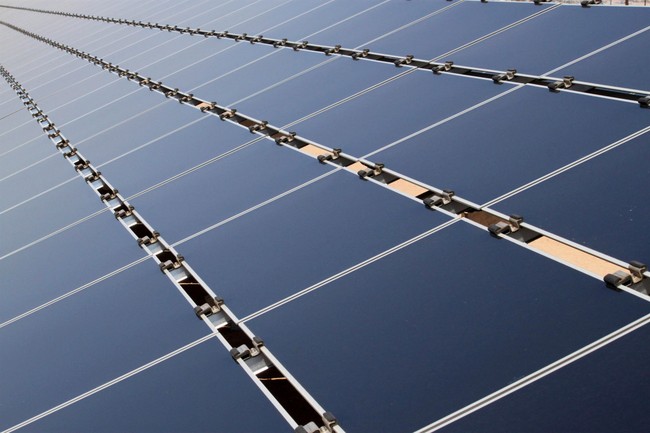It’s always something with the Green Grifters.
The latest out of the once bustling metropolis of Detroit is the mayor’s plan to continue his battle against urban blight and resident flight by, oh…not refurbishing houses or building new ones on the vacant sites littering the city.
Well, shoot – some aren’t even vacant – they’re just not pretty. But they still have occupants and renters in them.
No worries.
Everybody gets to leave, and the roofs over their heads come down in the name of ‘FIGHTING CLIMATE CHANGE.’
But mainly, it sounds like they’re getting booted to help pay for the electricity used by the buildings the city government runs.
…Mayor Mike Duggan announced that Gratiot-Findlay, Van Dyke-Lynch and the State Fair neighborhoods are part of the first phase selections of Detroit’s solar neighborhoods initiative, which the city announced last year, to generate clean energy to offset electricity used by all 127 municipal buildings.
“Today, Detroit takes a step into a major national leadership role in fighting climate change,” Duggan said Monday, adding:. “127 city buildings are currently powered by 33 megawatts of energy per year from traditional sources, largely fossil fuels. In the next two years, we are going to build solar fields that are going to produce that 33 megawatts of energy in renewable energy, effectively generating all the power for city buildings from solar fields. We’re doing it, while at the same time, helping neighborhoods that think they have been forgotten.”
The first phase of neighborhoods contains 100 acres of ground with 21 owner-occupied houses. Owners signed an agreement to sell their homes and move, in exchange for $90,000.
…”If you’re a renter, we will be giving you money to move and 18 months free rent,” Duggan said. “If you are a landlord or you own vacant lots, we’re gonna pay your fair market value. We have sent the City Council the documents asking us to move forward in condemnation. Those folks will be treated fairly, but there’ll be more than 900 parcels we’re going to have to acquire in phase one … the people who have owned the vacant houses and the landlords, they deserve a fair check. But they don’t deserve to get rich in a neighborhood that’s been largely abandoned.”
I know – what a cynic. And the language – no one ‘deserves to get rich’ in a ‘largely abandoned neighborhood’ so the city will be taking your property, thank you very much. Even if the reason you didn’t and couldn’t develop it was because the neighborood was ‘largely abandoned’?
WHUT
The Detroit City Council was a little leery about the moonlig…sunlight and roses picture being painted for them, too, even as advocates berated them with ‘but we’ve been working on this for over a year’ complaints.
This past July, one member made sure to point out that, like, actually, most of the council hadn’t been talking about the big plan at all and they would kind of like to know a little more about it. as the proposal concerned starting a fund to pay for all of this, for one thing.
And they hadn’t been assured it was even legal for another, which is one reason some members were a bit miffed at the mayor for announcing the project before it was even discussed and voted on.
…Councilmembers Angela Whitfield-Calloway and Latisha Johnson sought to delay the vote until after the nine-member body returns from a monthlong recess, which begins in August, to fully understand the project and the requested outside legal analysis to finalize any details.
…Johnson disputed that. “I do think it’s disingenuous to me, at least based on when I received the information, to say that we’ve got this, that we’ve been working on this for a year. Yes, some facet of the city has been working on this for a year, and I think it’s important to understand that while the administration has been working on it for a year, we’re not asking for a year to review the detailed information that had been provided to us. We’ve had over three weeks,” Johnson said. “We’ve received probably 20 documents that are detailed, and we’re trying to comb through that and make sure we understand what it is that we’re being asked to support and make sure that it is right for the communities.”
…Councilmembers are slated to vote on a solar equity fund, which will finance the project through the utility conversion fund, land acquisition and 35-year contracts with DTE and Lightstar Renewables.
A multitude of reasons, such as Mayor Mike Duggan holding an announcement before City Council approval, along with questions about the legality of the project, led council members to delay voting on the project several times. However, in an email to the Free Press, Duggan’s office of sustainability said the administration announced the initiative a year ago, held one-on-one meetings with council members and provided updates during charter-mandated meetings and his State of the City address.
What blue mayors want, they usually eventually get, and so Mayor Duggan eventually got the okay for his urban solar farm project this fall, but not before – again in big blue city tradition – handing out some neighborhood greasing lagniappe to make the first phase of the project easier to swallow.
Not only is the city ‘buying’ the vacant lots and paying for 18 months’ worth of rent for displaced renters if they lived in one of the ‘blighted’ buildings, but they’re going to spruce up adjacent dwellings.
SCHWEET
…“This program is a game changer for our community transforming vacant lots into sites of clean energy production. Economically, this initiative offers substantial benefits … it creates local jobs from installation to maintenance, boosting employment opportunities and stimulating our economy,” Gilstorf said, adding that homeowners in the vicinity ”receive substantial compensation, energy efficiency upgrades with at least $15,000 per home, with potential reductions in energy bills by 10%.”
…Owners of 159 adjacent homes will receive various home improvements, ranging from $15,000 to $25,000 of work, including: windows, roof repairs, residential solar panels, energy-efficient appliances, home insulation and air sealing, energy-efficient furnaces and water heaters, smart thermostats, energy-efficient lighting or battery backup.
I thought this city was broke? Vurt da furk?
Ooohhh…I get it.
You and I are paying for all the new bling.
…Funding for the Project – Made Possible by Tax Credits from the Inflation Reduction Act
Mayor Duggan explained the reason city is undertaking the solar power project now is that it only became financially viable because of the Inflation Reduction Act of 2022. “President Biden reduced the costs of large-scale solar projects like Detroit’s by 30% through the automatic tax credits in the Inflation Reduction Act,” the Mayor said. “Communities across America need to stop talking about fighting climate change and start to act. Under the new law, large-scale solar projects make good financial sense.”
The mayor and his green team didn’t waste any time moving on out while moving residents and owners on off those ‘vacant’ and ‘blighted’ parcels. I guess they saw how the electoral wind was blowing and knew they had to hustle before the Green Grift Buster got elected and the gig was up.
If you don’t want to sell for solar, well…tough.
Detroit’s ambitious solar neighborhoods project is drawing attention as the city files dozens of eminent domain lawsuits to secure land for its first phase. The project, which aims to generate enough solar energy to power Detroit’s 127 municipal buildings, is stirring up debates about eminent domain—a topic particularly sensitive in Michigan, where property rights and redevelopment have collided before.
The Detroit City Council approved the project in July 2024, and since then, the city has filed at least 89 lawsuits to acquire land. These lawsuits, which chief strategy officer Trisha Stein told to the Detroit Free Press “represent less than 10% of the more than 900 parcels” involved in the first phase, are part of a legal process known as eminent domain.
Those supporting the city project dismiss criticism of the eminent domain efforts as being much ado about nothing. Nobody wanted this ruined land anyway.
…Much of the land targeted for the solar farms is in Detroit’s “most blighted areas,” according to Mayor Mike Duggan. Similarly, eminent domain attorney Alan Ackerman informed the Detroit Free Press that “the lands that are being expropriated here are not in high demand.”
Ackerman continued: “Vacant lots are difficult. There are residential lots that are really valuable in the city and others just aren’t. Most of the things they condemn are found in the most ruined areas of the city.”
Residents remain skeptical as the city has already partnered with DTE Electric Company once before on a large urban solar farm, and the community benefits that were promised never really materialized. The city got a couple of flashy handouts from DTE with enough electricity generated for 450 homes, but DTE was the one who came out on top of the deal.
In 2019, the city office pushing for more urban solar used the time-honored ‘they just didn’t do it right‘ to pooh-pooh resident reluctance even then.
…DTE did partner with the city on a 10-acre solar project at O’Shea Playground that came online in 2017. DTE and the city agreed to a one-time lease payment of $25,000 covering 20 years. The project is utility-owned, though at the time it was announced, DTE touted the project for spurring neighborhood development.
Advocates criticized the project as mostly benefiting DTE.
“What we don’t want is a whole bunch more O’Shea solar projects,” Koeppel said.
Joel Howrani Heeres, director of the city’s sustainability office, said the O’Shea project is not the best model for solar in Detroit because it would be difficult to replicate, but he pushed back against the assertion that it did not include buy-in from the community. He cited extensive outreach with neighbors and home energy assessments done for nearby residents to lower energy bills.
Fast forward 6 years, and here they are again with the same cast of characters singing the same sunny solar song.
I wonder what the urban heat island effect is going to be in those neighborhoods with acres of solar panels baking in the summer? Cities are notoriously unbearable to begin with – why not make it more intolerable for residents in the name of saving the earth?
I doubt any of the city’s less savory inhabitants in those blighted neighborhoods would be interested in the off-market value of the wires, connectors, and the various other precious little pieces that make up a large solar farm. I’m sure simple vandalism would never cross anyone’s mind, although residents in the selected neighborhoods have thought of it, among other issues like their property values.
…Measha Parker has lived in Gratiot-Findlay for 18 years. She’s president of her block and said she hoped the fenced-in panels on 24 acres would help fight illegal dumping and drive out illegal drugs in the area.
She’d also like to see the former Wilkins Elementary School building, which has sat vacant for years, demolished as part of the plan. But she is concerned about vandalism and hopes the solar arrays will have surveillance cameras.
About that heat island thingee…
…“It’s not going to increase anybody’s property value. It’s not going to make it look more beautiful. And it’s not going to increase your access to green space,” he said. “It’s going to be like a little prison for solar panels.”
A recent study found solar installations in California, Connecticut, New Jersey, Minnesota, and Massachusetts reduced property values by 1.5% within half a mile, and outcomes varied by state.
Kemp added that the solar fields would tie up land the city could use for open space and green infrastructure to sequester stormwater and prevent basement flooding. He also worries that trees would need to be cut down to reduce shade on the panels.
Experts consider tree cover important for reducing heat and managing stormwater. And while solar power is considered critical for dealing with the climate crisis, solar fields can create a localized increase in temperature.
This may pose a special problem in Detroit, where the heat island effect, or the capacity of impervious surfaces to absorb and re-emit heat, already increases temperatures by 8 degrees or more.
YOWSAHS
Well, considering Michigan’s near-constant cloud cover, maybe it won’t be so bad.
Michigan has more cloud cover than nearly every other state making solar power about as efficient as Biden’s border control. pic.twitter.com/hUGoWgPm77
— John Preston (@Gramcleric) November 23, 2024
Although the panel efficiency won’t be anywhere near enough to light all 127 municipal buildings.
November seems dreary for renewables in Northern climes – dunkelflautes in Deutschland and downright dreary in Detroit.
Feeling cloudy? It’s because metro Detroit has only had 2 clear days this November
As we move through November and into December, shorter days and cloudier days are here. But have you recently thought that we haven’t seen the sun in metro Detroit for a while? Well, we haven’t.
In fact, metro Detroit has seen mostly cloudy days dating back nearly two weeks, according to National Weather Service preliminary climate data.
Nothing says ‘BET THE FARM ON SOLAR PANELS HERE‘ like being the city with the worst unemployment rate in the country, the second highest childhood and adult poverty rate in the country, all in the seventh cloudiest state in the country.
Subsidies for energy worldwide amounts to trillions of dollars. Without subsidies & the deliberate destruction of established energy industries, ‘renewable’ energy would vanish at a stroke. The entire argument for unreliable, costly & destructive wind & solar is based on a hoax. pic.twitter.com/BJfNY4SiXX
— Peter Clack (@PeterDClack) November 25, 2024
It’s our only money and Democratic #mathz in a blue city.
Spend it while you think you still got it.
Read the full article here




![Chicago Democrat Threatens Cops After Crashing Her Car While Drunk [WATCH] Chicago Democrat Threatens Cops After Crashing Her Car While Drunk [WATCH]](https://www.lifezette.com/wp-content/uploads/2024/11/2024.11.26-01.56-lifezette-6745d39dc352b.jpg)
![Judge Will Allow Jury to See This Assault Video [WATCH] Judge Will Allow Jury to See This Assault Video [WATCH]](https://www.boredtrashpanda.com/wp-content/uploads/2025/04/2025.04.26-09.58-boredtrashpanda-680cae5940953.jpg)



![China Eases Tariffs Amid Trump’s Trade Pressure [WATCH] China Eases Tariffs Amid Trump’s Trade Pressure [WATCH]](https://www.lifezette.com/wp-content/uploads/2024/11/2024.11.27-01.37-lifezette-6747208c54f7f.jpg)